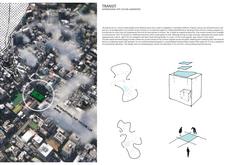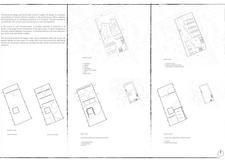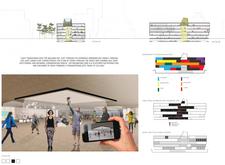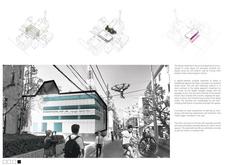5 key facts about this project
At its core, "Transit" serves multiple functions, acting as a gallery, performance space, and a hub for cultural dialogue. The design considers the needs of diverse user groups, creating spaces that accommodate exhibitions, workshops, and community gatherings. This multifunctional approach underscores the project's commitment to making cultural experiences accessible to all, regardless of their background.
The overall design is characterized by a carefully orchestrated spatial organization that promotes interaction between users and the environment. The architectural footprint of the building is intentionally designed to create open public areas that invite foot traffic and exploration. By blurring the boundaries between the interior and exterior, the project encourages a seamless flow of movement, allowing visitors to engage with both the cultural activities within and the urban landscape surrounding the site.
Materiality plays a crucial role in the project’s identity, with a selection of elements that contribute to both aesthetics and functionality. The use of glass facilitates transparency, allowing natural light to penetrate deep into the interior spaces and forging a connection with the outdoors. Steel elements provide structural assurance while maintaining a contemporary appearance. Wood adds warmth and a tactile quality that enriches the user experience, while concrete anchors the structure within the urban context. This diverse palette of materials is chosen not only for their visual appeal but also for their practical benefits, all contributing to a sustainable architectural approach.
One of the unique design approaches of "Transit" lies in its commitment to environmental considerations. Sustainable practices are woven into the fabric of the design, with features such as green roofs and strategically placed light wells that enhance energy efficiency and provide natural ventilation. These elements demonstrate an intention to reduce the building's ecological footprint while creating a healthy and inviting atmosphere for occupants.
Spatially, the design includes a vertical circulation system that encourages exploration across different levels. Accessibility is a priority, with ramps and open staircases allowing for fluid movement throughout the facility. This layout fosters a sense of community, encouraging serendipitous encounters and spontaneous interactions among users. Flexible spaces equipped with movable partitions allow the venue to adapt to a variety of events and functions, reinforcing the project's identity as a cultural hub.
"Transit" also integrates technology in ways that augment the cultural experience. This includes interactive displays and virtual interfaces that bridge the gap between traditional exhibitions and modern digital engagement. Such features underscore the project’s relevance in a rapidly evolving cultural landscape, encouraging visitors to interact not just with the space but also with the content presented within.
By emphasizing a design that prioritizes interaction, adaptability, and sustainability, "Transit" stands as a commendable example of contemporary architecture that respects and enhances its urban surroundings. The careful attention to material selection, spatial organization, and user experience all highlight a commitment to thoughtful design principles.
For those interested in understanding the nuances of this architectural endeavor, exploring the architectural plans, sections, and designs will offer a deeper insight into the innovative ideas that inform the project. Engaging with these elements provides an opportunity to appreciate the manifold layers of thought and creativity that shape "Transit" as a vital addition to the cultural landscape.


























